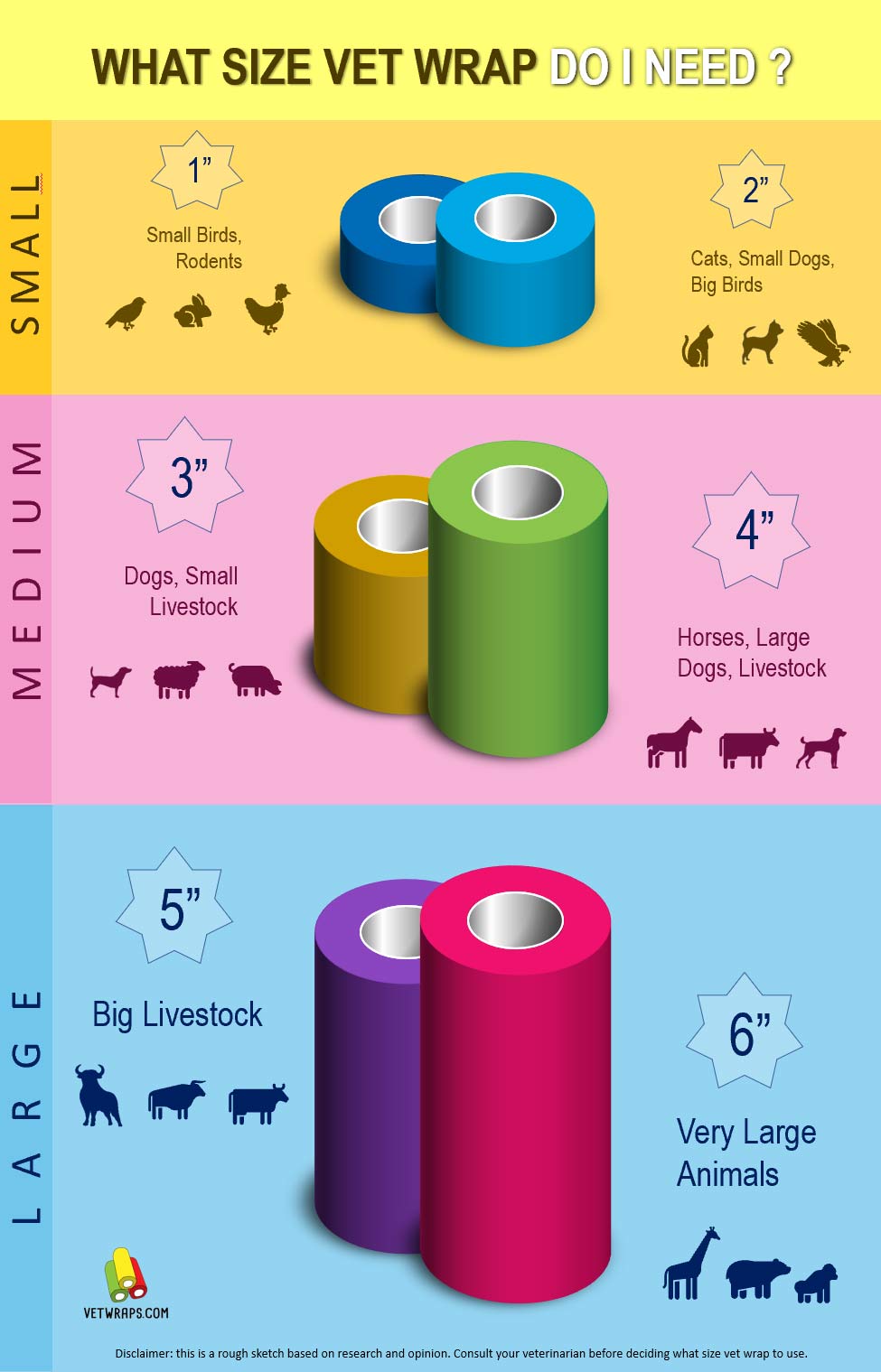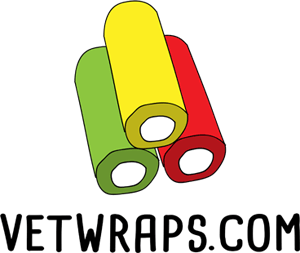What Size Vet Wrap Should I Choose?

Vet wrap is a bandage that sticks to itself. It is flexible and stretchy. It is strong enough to provide firm pressure and support without any adhesives. But making the best choice among one-inch, two-inch, three-inch, four-inch, five-inch, and six-inch widths in vet wrap sizes makes a big difference in performance.
How can veterinarians, pet owners, and other animal caretakers choose the best size vet wrap? Is it all about width? Is it a question of bandage size? Do we need to look at vet wrap length? The simple fact is that when it comes to vet wrap, one size does not fit all. But choosing the right vet wrap size can mean choosing between competing needs.
Let's take a look at why we use bandages in general and vet wrap in particular.
Vet Wrap Reduces Bioburden
Bacteria allowed to proliferate in a wound interfere with healing. They prolong inflammatory reactions. They slow down the process of granulation needed to close a wound. They can form biofilms that protect them against antibiotics.
Assuming a wound is washed and treated with antibiotics or antibacterials before it is bandaged, the bigger the bandage, the lower the bioburden. Vet wrap will not remove bacteria that are left in a wound before it is covered. Bandage size makes a difference, and the best size vet wrap would seem to be wider rather than narrower. But controlling bioburden by keeping bacteria and other infectious microorganisms out is not the only reason for using vet wrap,
Vet Wrap Controls Swelling
Animals can experience edema after injury. Less often, edema can follow lymphatic disease or metabolic disorders. Gentle pressure reduces edema. Vet wrap does a better job of controlling edema in larger animals, such as horses, than other choices of bandages. But choices among vet wrap sizes make a difference in how well wrapping reduces swelling.
Every bandage exerts more pressure at its center than along its edges. The way to compensate for this effect is to wrap a limb or tail with multiple layers of vet. A given point on the animal's skin may receive less pressure because it is under the edge of one layer of vet wrap but more pressure because it is under the middle of another layer of vet wrap.
Choosing a narrower width of vet wrap allows for even pressure over swelling. Wrapping an area of edema with multiple layers of vet wrap equalizes pressure. Of course, the animal has to cooperate with the caretaker in this process of wrapping an area of edema. Veterinarians, trainers, and owners of horses with tendencies to kick may choose wider widths of vet wrap, even the five-inch and six-inch sizes, so they themselves are less likely to be injured.
Vet Wrap Stabilizes Moist Dressings
The right amount of moisture is essential in wound healing. Most wounds heal better in a moist environment. Hydration of injured skin helps fibroblasts move through the wound to deposit new collagen to form a scaffold for new skin. Modern dressings wick away excessive moisture. They lock cellular debris and bacteria into the dressing itself. But they have to kept in contact with the skin.
Holding a dressing in place is better accomplished with a narrower width of vet wrap applied in multiple layers. Unless the wound is round, pressure from bandages will be greater in the center of the wound than at its edges. More layers of narrow vet wrap do a better job of holding the moist dressing over the entire wound, all the way out to its edges. But if holding the animal still is an issue, then it can be better to use fewer layers of wider vet wrap rather than more layers of narrower vet wrap to get the procedure done quickly.
So, is there really a single best vet wrap size? The conventional wisdom is:
- Choose four-inch vet wrap for horses and other large animals.
- Use two-inch vet wrap or three-inch vet wrap cut down the middle on larger dogs. There will be more on that second option a little further in this article.
- Reserve one-inch vet wrap for cats.
A four-inch width is optimal for most but not all applications of vet wrap in horses. If the horse is excited or in pain, then five-inch or six-inch vet wrap enables the caretaker to finish treatment faster. It's also important to choose brands of vet wrap that can be torn. Do not buy vet wrap that has to be cut with scissors. There are many situations that cutting a neat edge on the vet wrap gives an animal an extra second to kick.
Two-inch vet wrap is optimal for most canine applications, in all but miniature or toy dogs. There is one important exception to this rule. The standard advice for wrapping ears of dogs that tend to get infections due to the leatheriness of their skin (such as Dobermans) is to cut three-inch vet wrap down the middle.
The reason for cutting three-inch vet wrap longitudinally is to give a measure of how much wrap provides a good level of pressure on the ear. Cut a 5-yard roll of three-inch vet wrap in half, and then use one half of the roll to each ear. Cutting vet wrap is time-consuming but it gives a good idea of how much wrap to use.
One-inch vet wrap is almost always best for treating cats, unless the animal is an extra-large feline, such as a Maine Coon cat. And one-inch vet wrap may be best for stabilizing catheters in positions that allow small animals of any species flexibility to eat, drink, and take care of elimination.
Best Vet Wrap Size?
There is no single best size vet wrap that works for every animal in every situation. There is no single best size vet wrap for any individual small or large animal in all situations. There may be times that the best way to keep a venous line in place in a horse requires one-inch vet wrap. There may be times that six-inch vet wrap is the best way to make a "kitty burrito" to comfort and stabilize an injured cat.
People who take care of animals should stock multiple rolls of vet wrap in multiple widths. The best vet wrap size for comprehensive care of animals big and small is "all of them" to be prepared for all the health emergencies that can occur in the course of their lives.
Oh, and this is not veterinary advice so by all means, consult your local vet.
